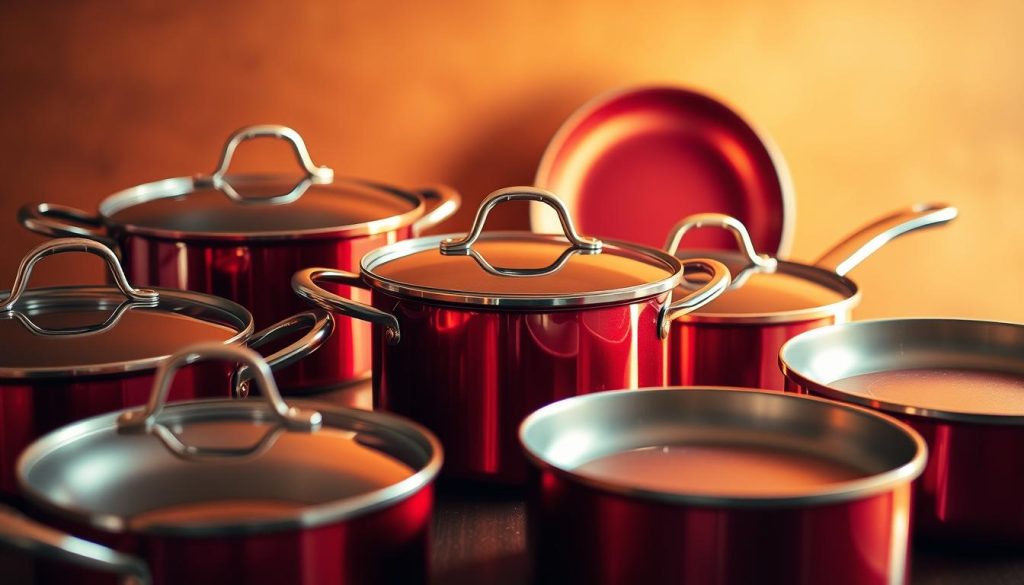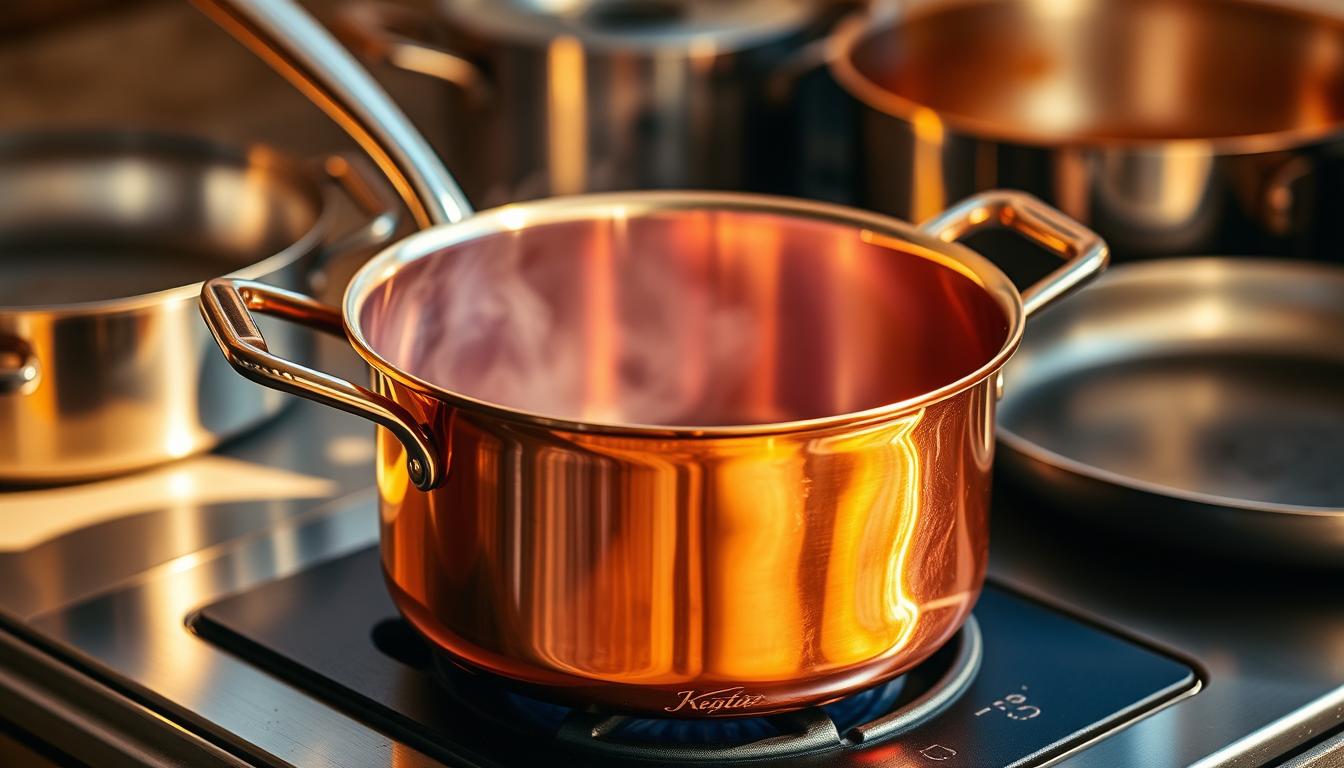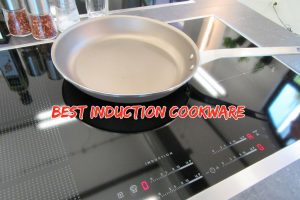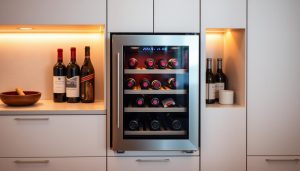Did you know 73% of home cooks blame their tools for inconsistent results, not their skills? The secret lies in how your pots and pans handle temperature shifts – a feature most never consider until dinner burns.
When you adjust your stove, quality materials like copper or aluminum-core stainless steel react instantly. Thin or poorly constructed pans create frustrating hot spots where food scorches while other areas stay raw. This isn’t about fancy gadgets – it’s basic physics determining whether your sear becomes crispy or charred.
Chefs prioritize this invisible trait because it lets them flip from high-heat searing to gentle simmering without swapping pans. Your weekend pancakes test this daily: do they brown evenly, or does the center stay doughy while edges crisp?
Key Takeaways
- Temperature control accuracy depends on your pan’s material science
- Copper and aluminum cores prevent uneven cooking better than single-layer metals
- Professional kitchens use multi-clad designs for immediate heat adjustments
- Modern layered construction balances speed and stability
- Consistent results require cookware that mirrors your stove’s output
Upgrading your kitchen tools starts with understanding these principles. You’ll never again wonder why recipes work perfectly for others but fail on your stove.
Introduction to Heat Responsiveness and Cookware Choices
The difference between a golden crust and a burnt mess lies in your cookware’s hidden trait. This feature determines whether your pan adapts to sudden flame adjustments or stubbornly holds onto scorching temperatures.

What Is This Hidden Trait?
It’s how swiftly your pots react when you twist the stove dial. Carbon steel shines here, racing from cold to searing-hot in seconds. Unlike thicker materials, it cools rapidly when you lower the flame—critical for delicate tasks like finishing pan sauces.
Why Should You Care?
Your favorite recipes demand precise control. Imagine searing steak on high, then instantly reducing heat to baste with butter. Stainless steel with aluminum cores offers similar speed, while cast iron’s slower reaction suits steady simmering.
Professional chefs prioritize this trait because it lets them pivot techniques mid-recipe. As one line cook notes: “Responsive tools turn split-second decisions into flawless dishes.” Your weekend brunch proves this—do pancakes cook evenly or burn at the edges?
Understanding Heat Responsiveness in Cookware Explained
Ever wonder why some pans cook evenly while others leave burnt patches? The answer lies in thermal physics – how materials move energy across their surface.

Material Matters More Than You Think
Your pan’s composition determines its cooking superpowers. Copper transfers energy 20x faster than stainless steel, while cast iron holds warmth like a battery. This dance between heat conductivity and retention decides your meal’s fate.
Three factors create perfect browning:
- Layered construction: Aluminum cores spread heat sideways
- Surface density: Thicker bases minimize hot spots
- Molecular bonds: Tight metal structures conduct evenly
Professional chef Lisa Yang explains: “Our kitchen uses copper-core pans because they mirror the stove’s output instantly. When I reduce heat for sauces, the pan follows suit – no lag time.”
Modern cookware combines materials strategically. A stainless exterior protects while aluminum channels heat across the surface. This hybrid approach gives you control that single-metal pans can’t match.
Comparing Cookware Materials: Cast Iron, Stainless Steel, and More
Material selection in pots and pans shapes every culinary outcome. Each metal behaves differently when flames hit its surface, creating distinct advantages for specific techniques.

Cast Iron’s Enduring Strengths
Cast iron cookware acts like a thermal battery. Once heated, it maintains steady temperatures for hours – perfect for searing steaks or simmering stews. Its dense structure continues cooking food even after you turn off the burner.
Enameled versions add a slick coating without chemical layers. Chef Michael Lomonaco notes: “My Dutch oven transitions from stovetop braising to oven roasting without losing heat.” Regular seasoning builds a natural non-stick surface over time.
Stainless Steel’s Precision Edge
Steel cookware with aluminum cores responds like a sports car. It reaches target temperatures fast and adjusts instantly when you change settings. This makes it ideal for delicate sauces or quick sautés.
Modern steel pans resist warping and dishwashers. Pair them with copper bases for restaurant-grade control. Non-stick options simplify cleanup but work best for low-heat tasks like eggs.
| Material | Best For | Heat Response | Maintenance |
|---|---|---|---|
| Cast Iron | Searing, baking | Slow | Season regularly |
| Stainless Steel | Sautéing, boiling | Fast | Dishwasher-safe |
| Carbon Steel | Stir-frying | Instant | Hand wash |
| Non-Stick | Eggs, fish | Moderate | Replace every 2-3 years |
Your cooking style dictates the winner. Cast iron excels at heat retention for hearty meals. Stainless steel offers agility for precision work. Choose based on what sizzles in your skillet most often.
How Heat Distribution Affects Your Cooking Results
Perfectly cooked meals aren’t magic – they’re science. Your tools’ ability to spread warmth evenly determines whether you master recipes or fight flare-ups.

The Silent Game-Changer in Your Kitchen
Uneven surfaces create culinary chaos. Thin pans develop scorching zones while thick bases stay lukewarm. Multi-layered cookware with aluminum cores solves this by moving energy sideways, not just upward.
Chef Marco Pierre White observes: “Great distribution lets me sear scallops without babysitting each piece. The pan works as hard as I do.” This precision preserves nutrients by avoiding prolonged exposure to extreme temperatures.
| Material | Hot Spot Risk | Ideal Use |
|---|---|---|
| Stainless Steel + Core | Low | Sautés, sauces |
| Cast Iron | Medium | Slow roasting |
| Carbon Steel | Low | High-heat searing |
| Basic Non-Stick | High | Low-temperature tasks |
Superior heat distribution means faster cooking times and consistent results. Proteins develop uniform crusts while vegetables caramelize evenly. This efficiency shines when using best-performing cookware designed for modern stovetops.
Your choice directly impacts meal quality. Invest in tools that eliminate cold zones, and watch your cooking confidence soar.
Choosing the Right Cookware for Your Cooking Style
Matching pots to your cooking habits transforms kitchen struggles into victories. Your tools should amplify strengths while compensating for weak spots in your technique. Let’s decode how to pair materials with methods for flawless execution.

Assessing Your Cooking Needs
Start by tracking your weekly meal patterns. Do you sear proteins daily or simmer soups weekly? Steel cookware excels for high-heat searing, while enameled cast iron handles acidic stews without reacting. Consider these factors:
- Frequency of elaborate vs. quick meals
- Stovetop-to-oven transitions needed
- Preferred cleanup methods
Chef Gabrielle Hamilton advises: “Home cooks often underestimate how their equipment shapes habits. Lightweight steel pans invite experimentation, while heavy pots anchor you to comfort foods.”
| Cooking Style | Ideal Material | Maintenance Level |
|---|---|---|
| Stir-frying | Stainless steel + aluminum core | Moderate |
| Slow braising | Enameled cast iron | Low |
| Delicate baking | Ceramic non-stick | High |
| Versatile everyday | Multi-clad stainless | Medium |
Evaluating Performance Versus Comfort
Professional-grade steel cookware offers precision but demands seasoning. Non-stick options simplify cleanup but limit high-heat techniques. Weigh these trade-offs:
- Heat control accuracy vs. easy handling
- Longevity vs. upfront cost
- Specialized vs. multi-purpose use
Weekend warriors might prioritize lightweight pots pans for casual meals. Aspiring chefs often invest in layered stainless steel for its adaptability across techniques. Your ideal set balances ambition with practical reality.
Tips for Preheating and Using Your Cookware Effectively
Mastering your skillet’s warm-up routine transforms random results into restaurant-quality dishes. Proper temperature preparation bridges the gap between raw ingredients and perfected textures.
Mastering the Warm-Up Phase
Start cold steel pans on low heat for 1 minute before increasing gradually. This prevents warping while letting metals expand evenly. Chef Thomas Keller advises: “Treat preheating like a countdown – rushing it guarantees uneven cooking surfaces.”
Test readiness by flicking water droplets onto the pan. Properly heated steel cookware makes water skitter like mercury, not sizzle violently. Cast iron requires 3-5 minutes of medium heat to develop its signature searing power.
- Season monthly with thin layer oil baked at 450°F
- Use wooden utensils to preserve non-stick coatings
- Adjust burner size to match pan diameter
Overcrowding drops temperatures rapidly. Leave 30% space between food pieces for consistent results. Lower the flame after adding ingredients – modern steel cookware retains enough heat to finish cooking without scorching.
Cleaning and Maintaining Cookware for Optimal Heat Retention
Your pans’ performance depends as much on post-meal care as cooking technique. Proper maintenance preserves the materials’ ability to transfer energy evenly, ensuring every sear and simmer stays consistent.
Material-Specific Care Essentials
For stainless steel cookware, use warm water and mild detergent immediately after cooling. Avoid abrasive pads – they scratch surfaces and create hotspots. Dry thoroughly to prevent rust and maintain conductivity.
Traditional cast iron needs different attention. Rinse with hot water (no soap) and scrub gently. Apply a thin layer of vegetable oil while warm to reinforce seasoning. Enameled versions tolerate mild soap but demand soft sponges.
Pair your best utensils for stainless steel with proper cleaning habits. Metal tools degrade non-stick coatings, while wood preserves surfaces. Consistent seasoning prevents food buildup that disrupts heat flow.
Weekly deep-clean sessions remove stubborn residues. For steel pans, boil water with baking soda for 5 minutes, then scrub. This routine keeps your tools functioning like new while protecting your investment.



